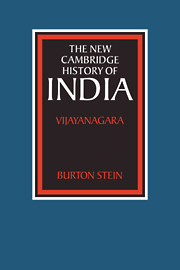Book contents
- Frontmatter
- 1 Introduction
- 2 The medieval past: continuity and disjunction
- 3 The city and the kingdom
- 4 Political economy and society: the sixteenth century
- 5 Imperial collapse and aftermath: 1542–1700
- 6 Conclusion
- Bibliographical essay
- Index
- THE NEW CAMBRIDGE HISTORY OF INDIA
- Frontispiece">
- Plate Section">
- References
- Frontmatter
- 1 Introduction
- 2 The medieval past: continuity and disjunction
- 3 The city and the kingdom
- 4 Political economy and society: the sixteenth century
- 5 Imperial collapse and aftermath: 1542–1700
- 6 Conclusion
- Bibliographical essay
- Index
- THE NEW CAMBRIDGE HISTORY OF INDIA
- Frontispiece">
- Plate Section">
- References
Summary
The kingdom or ‘empire’ of Vijayanagara takes its name, ‘City of Victory’, from its capital on the Tungabhadra River, near the centre of the sub-continent. Its rulers over three centuries claimed a universal sovereignty – ‘to rule the vast world under a single umbrella’ – and they also, more modestly, referred to themselves as the rulers of Karnata, modern Karnataka. This seemingly humble reduction of the scope of their suzerainty from the world to a small portion of the Indian sub-continent is somewhat deceptive. Vijayanagara kings seemed to have had the sense that the kingdom established in the fourteenth century revived an earlier universal sovereignty in Karnataka, that of the Chalukyas of Badami (ancient Vatapi in Bijapur district of modern Karnataka). Vijayanagara kings adopted the emblem of the Chalukyas, the boar, or varaha, and perhaps quite consciously modelled their capital on the Chalukyan capitals of Vatapi and Aihole of the sixth to eighth centuries, though Vijayanagara in 1500 was a great fortified place covering 10 square miles, dwarfing the Chalukyan cities. Even so, the first temples which they built in the city were somewhat enlarged replicas of those found at Chalukyan capitals.
Also as with the Chalukyas, there were several distinct lineages, or dynasties, of Vijayanagara rulers. The first of these was sometimes called Yadavas, but was more often known as Sangamas, for the chief whose sons established the kingdom around 1340. Descendants of one of the sons of Sangama, who ruled as Bukka I (reign, 1344–77), expanded the city and realm until the late fifteenth century when a second, or Saluva, ruling line was established briefly by a Vijayanagara generalissimo, Saluva Narasimha.
- Type
- Chapter
- Information
- The New Cambridge History of IndiaVijayanagara, pp. 1 - 12Publisher: Cambridge University PressPrint publication year: 1990



